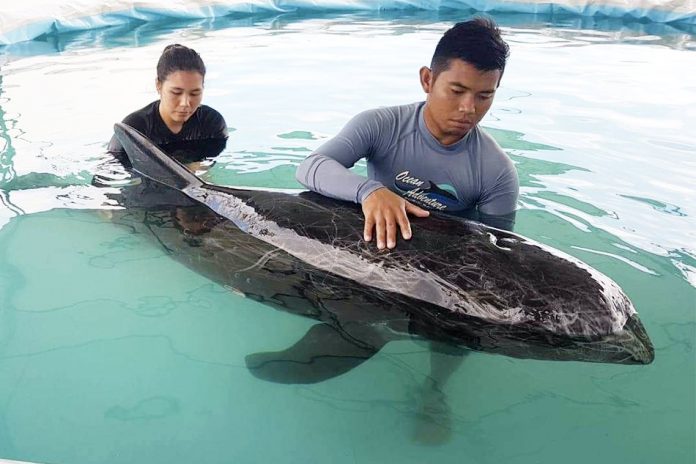
BACOLOD City – In mid-January, a Risso’s dolphin was found floundering off the coast of Playa La Caleta resort in Morong, Bataan. Scratch marks and a sizeable wound covered its gray body, inflicted during an encounter with a shark. Action was swift, and soon the local coast guard, the Philippine National Police and Bantay Dagat rangers had the dolphin off on its way to rehabilitation. “Courage,” they named it.
Playa La Caleta scrambled to establish the proper team to execute the rescue within the next 2 hours. He was named “Courage” because despite the wounds, infection, and lowered blood and heart pressure, he remains a fighter.
“[In cases such as this], community participation is vital, especially when reporting them to concerned agencies,” says Mavic Matillano, project manager of the Improved Fisheries Project of the World Wide Fund for Nature (WWF) Philippines. “If these agencies make an effort to educate communities [on what to do], then these stranded dolphins, and all wildlife for that matter, will have a higher chance of surviving.”
Local news and social media was quick to pick up on the story. It’s not every day we get to save a dolphin, after all, especially one as injured as “Courage” was. As the good news got round, however, a tragedy flew by under the radar.
On the following Sunday, Jan. 13th, an Irrawaddy dolphin was found rotting off the coast of Sitio Can-Itum in Bago, Negros Occidental. The carcass was well-rotted, but a large gash running along its side suggested death by injury. Man-made or not, they couldn’t tell.
“What happened in Bago is an example of a community acting normally over something that technically doesn’t have any direct bearing on their immediate economic concerns,” says Matillano. “Since it was already Code 4, or dead, there really was no rush to rescue [the Irrawaddy.]”
The Irrawaddy may have been past the point of rescue, unlike Courage, but its death is still a point of concern in light of other recent, massive stranding incidents. In 2009 a stranding event left 500 dolphins beached on the shores of Bataan. Fast-acting media reports led to quick action, which meant only three dolphins perished. So massive a stranding, however, had never been seen before.
What’s the cause behind such stranding events? Everything from stress and disease to oceanic noise pollution and climate change leaving dolphins disoriented, experts suggest. Anthropogenic causes are always seen as a shadowy culprit behind these incidents, too.
It may have been too late for the Irrawaddy found in Negros, but stories like that of “Courage” show that when trouble strikes and an animal finds itself in danger, we have the ability to do something about it. Good community education will help save many more dolphins—and with comprehensive conservation work and careful care of the way we treat our oceans, perhaps all creatures will have a little bit more of a fighting chance. (ANC)


![Jaro archbishop calls for prayers following death of Pope Francis “I call upon our faithful in the Archdiocese to offer prayers for his [Pope Francis] eternal repose. What remains now is to continue to pursue the dream he cultivated — that God is near and journeys with us," says Jaro Archbishop Midyphil Billones. JARO METROPOLITAN CATHEDRAL PHOTO](https://www.panaynews.net/wp-content/uploads/2025/04/archbishop_1_resized-218x150.jpg)




